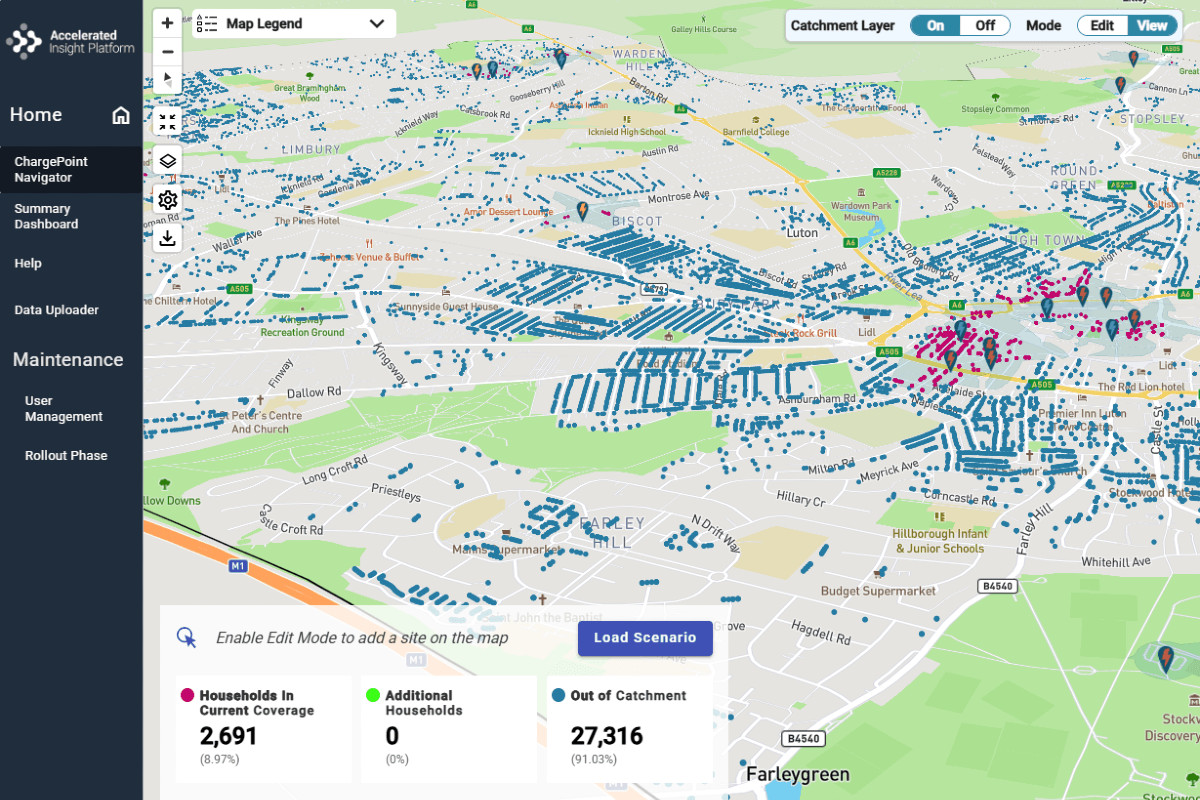Local authorities using a new digital planning tool, ChargePoint Navigator, have secured a 100% first-time success rate in bids to the Government’s Local Electric Vehicle Infrastructure (LEVI) fund, compared with a 37% success rate among councils that did not use the tool.
The results are published in Powering Local EV Infrastructure: A Guide for Councils, a new guide produced by local climate network UK100, UK Power Networks’ Distribution System Operator (DSO) and Cenex. The LEVI fund provides £381 million to support around 100,000 new public chargepoints across England.
Data-led planning boosts LEVI success
ChargePoint Navigator is a free digital planning tool developed by UK Power Networks DSO with support from delivery partner Field Dynamics, collaborator Cenex and data provider Zapmap. According to the partners, every council that used the tool for its first-round LEVI application has had its bid approved.
By combining data on available electricity network capacity, pavement widths, on-street households and localised EV demand projections, the tool is designed to help councils identify viable chargepoint sites earlier in the process and build more robust investment cases.
Authorities including Kent County Council and Brighton & Hove City Council have used ChargePoint Navigator to coordinate district-wide planning, identify priority locations, engage chargepoint operators, support procurement decisions and track delivery after contracts are awarded.
The partners argue that this type of evidence-based planning will be critical if the LEVI programme is to deliver on its objectives at a time when EV adoption is rising but many councils still face technical, financial and operational constraints.
End-to-end guide for councils
The new guide is aimed at officers and elected members involved in EV, transport, climate and place-based planning. It is structured to support councils through the full lifecycle of an EV infrastructure programme, from early strategy to delivery on the ground.
Topics include how to:
- Match different chargepoint types to local travel and parking patterns
- Build business cases and structure long-term partnerships with chargepoint operators
- Minimise grid connection costs through early engagement with network operators
- Take a portfolio approach that balances higher- and lower-demand areas to support equitable access
- Work effectively with wider partners, including distribution network operators (DNOs), DSOs, regional Net Zero Hubs, central government and community groups
Developed jointly by UK100 and UK Power Networks DSO, in partnership with Cenex, the guide combines local government insight, energy-system expertise and input from a LEVI support body. It is available to all local authorities across England.
The partners say the aim is to give councils a clearer route from strategy documents to commissioned chargepoints, with a particular focus on residents who do not have access to off-street parking.
Local authorities ‘central to the EV transition’
Christopher Hammond, Chief Executive of UK100, noted, “Local authorities are absolutely central to making the electric vehicle transition work for everyone, yet too many councils have struggled to navigate the complex funding, technical and commercial challenges involved. Until the way local climate action is funded is fundamentally reformed, this new guide is indispensable.
“This collaboration between UK100, UK Power Networks DSO and Cenex brings together policy expertise, technical infrastructure knowledge and practical delivery experience in a way that helps councils create thriving places powered by clean energy and clean air.”
Lynne McDonald, Head of Local Net Zero at UK Power Networks, added, “Local authorities are clear about what their communities need, and our job is to help them deliver it. We’re proud to work with UK100 and Cenex to create a guide to help councils navigate the end-to-end journey of getting electric vehicles moving.
“In the guide we highlight ChargePoint Navigator, a digital tool developed by Field Dynamics alongside partners Cenex and Zapmap. It was built around councils’ need for straightforward insights on existing chargepoints, areas of charging need and data on where to connect in one place, so they can plan confidently and secure funding first time. The 100% LEVI success rate shows the impact of listening to our customers and responding with tools that genuinely solve their challenges.”
Chris Rimmer, Head of Department, Policy, Strategy and Implementation at Cenex, concluded, “Local authorities are at the heart of the electrification revolution and critical players as we seek to clean and green our streets and our environment. This guide showcases key examples of collaboration and innovation from UK Power Networks and others who are powering local EV infrastructure across the UK.”

